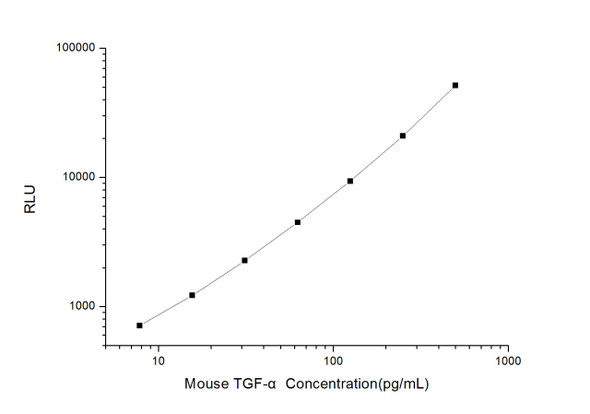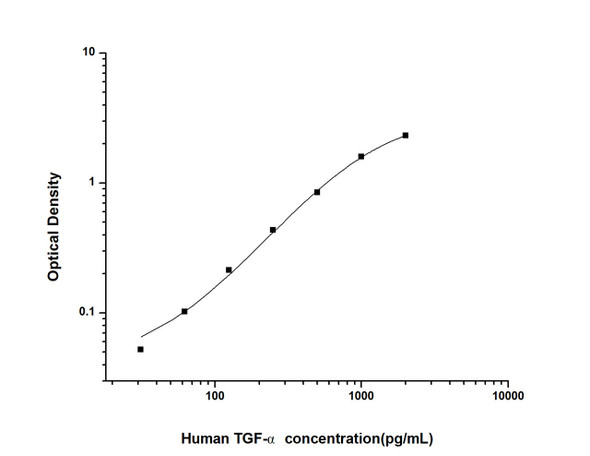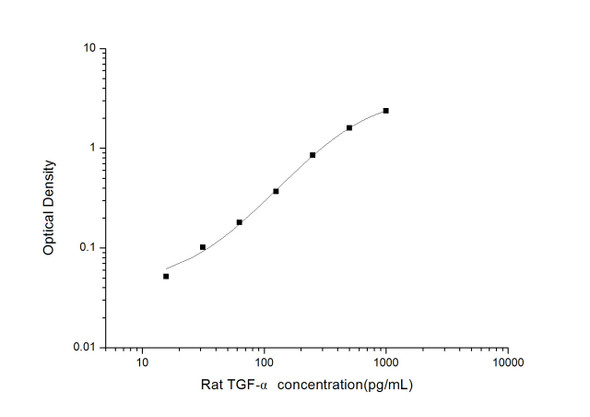Human Cell Biology ELISA Kits 5
Human TGF- alpha (Transforming Growth Factor alpha) CLIA Kit (HUES00902)
- SKU:
- HUES00902
- Product Type:
- ELISA Kit
- ELISA Type:
- CLIA Kit
- Size:
- 96 Assays
- Sensitivity:
- 4.69pg/mL
- Range:
- 7.81-500pg/mL
- ELISA Type:
- Sandwich
- Reactivity:
- Human
- Sample Type:
- Serum, plasma and other biological fluids
- Research Area:
- Cell Biology
Description
| Assay type: | Sandwich |
| Format: | 96T |
| Assay time: | 4.5h |
| Reactivity: | Human |
| Detection method: | Chemiluminescence |
| Detection range: | 7.81-500 pg/mL |
| Sensitivity: | 4.69 pg/mL |
| Sample volume: | 100µL |
| Sample type: | Serum, plasma and other biological fluids |
| Repeatability: | CV < 15% |
| Specificity: | This kit recognizes Human TGF- alpha in samples. No significant cross-reactivity or interference between Human TGF- alpha and analogues was observed. |
This kit uses Sandwich-CLIA as the method. The micro CLIA plate provided in this kit has been pre-coated with an antibody specific to Human TGF- alpha. Standards or samples are added to the appropriate micro CLIA plate wells and combined with the specific antibody. Then a biotinylated detection antibody specific for Human TGF- alpha and Avidin-Horseradish Peroxidase (HRP) conjugate are added to each micro plate well successively and incubated. Free components are washed away. The substrate solution is added to each well. Only those wells that contain Human TGF- alpha, biotinylated detection antibody and Avidin-HRP conjugate will appear fluorescence. The Relative light unit (RLU) value is measured spectrophotometrically by the Chemiluminescence immunoassay analyzer. The RLU value is positively associated with the concentration of Human TGF- alpha. The concentration of Human TGF- alpha in the samples can be calculated by comparing the RLU of the samples to the standard curve.
| UniProt Protein Function: | TGFalpha: TGF alpha is a mitogenic polypeptide that is able to bind to the EGF receptor/EGFR and to act synergistically with TGF beta to promote anchorage-independent cell proliferation in soft agar. Interacts with the PDZ domains of MAGI3, SDCBP and SNTA1. The interaction with SDCBP, is required for the targeting to the cell surface. In the endoplasmic reticulum, in its immature form (i. e. with a prosegment and lacking full N-glycosylation), interacts with CNIH. In the Golgi apparatus, may form a complex with CNIH and GORASP2. Interacts (via cytoplasmic C-terminal domain) with NKD2. Isoform 1, isoform 3 and isoform 4 are expressed in keratinocytes and tumor-derived cell lines. 5 isoforms of the human protein are produced by alternative splicing. |
| UniProt Protein Details: | Protein type:Cell cycle regulation; Ligand, receptor tyrosine kinase; Membrane protein, integral; Motility/polarity/chemotaxis Chromosomal Location of Human Ortholog: 2p13 Cellular Component: extracellular space; cell surface; basolateral plasma membrane; perinuclear region of cytoplasm; integral to plasma membrane; plasma membrane; cytoplasmic vesicle; nucleus Molecular Function:protein binding; growth factor activity; glycoprotein binding; epidermal growth factor receptor binding Biological Process: response to drug; epidermal growth factor receptor signaling pathway; cell proliferation; positive regulation of epidermal growth factor receptor activity; wound healing; positive regulation of mitosis; activation of MAPK activity; angiogenesis; positive regulation of epithelial cell proliferation; negative regulation of apoptosis |
| NCBI Summary: | This gene encodes a growth factor that is a ligand for the epidermal growth factor receptor, which activates a signaling pathway for cell proliferation, differentiation and development. This protein may act as either a transmembrane-bound ligand or a soluble ligand. This gene has been associated with many types of cancers, and it may also be involved in some cases of cleft lip/palate. Alternatively spliced transcript variants encoding different isoforms have been found for this gene. [provided by RefSeq, Sep 2011] |
| UniProt Code: | P01135 |
| NCBI GenInfo Identifier: | 135689 |
| NCBI Gene ID: | 7039 |
| NCBI Accession: | P01135. 1 |
| UniProt Secondary Accession: | P01135,Q15577, Q53SK7, Q9BS56, Q9UEI3, Q9UKM1, Q9UKM2 Q9UKM3, A8K286, |
| UniProt Related Accession: | P01135 |
| Molecular Weight: | 17,329 Da |
| NCBI Full Name: | Protransforming growth factor alpha |
| NCBI Synonym Full Names: | transforming growth factor, alpha |
| NCBI Official Symbol: | TGFA |
| NCBI Official Synonym Symbols: | TFGA |
| NCBI Protein Information: | protransforming growth factor alpha; TGF-alpha |
| UniProt Protein Name: | Protransforming growth factor alpha |
| UniProt Synonym Protein Names: | EGF-like TGF; ETGF; TGF type 1 |
| Protein Family: | Transforming growth factor |
| UniProt Gene Name: | TGFA |
| UniProt Entry Name: | TGFA_HUMAN |
As the RLU values of the standard curve may vary according to the conditions of the actual assay performance (e. g. operator, pipetting technique, washing technique or temperature effects), the operator should establish a standard curve for each test. Typical standard curve and data is provided below for reference only.
| Concentration (pg/mL) | RLU | Average | Corrected |
| 500 | 48075 54999 | 51537 | 51508 |
| 250 | 19809 22187 | 20998 | 20969 |
| 125 | 9884 8908 | 9396 | 9367 |
| 62.5 | 4456 4568 | 4512 | 4483 |
| 31.25 | 2470 2128 | 2299 | 2270 |
| 15.63 | 1314 1186 | 1250 | 1221 |
| 7.81 | 731 749 | 740 | 711 |
| 0 | 28 30 | 29 | -- |
Precision
Intra-assay Precision (Precision within an assay): 3 samples with low, mid range and high level Human TGF- alpha were tested 20 times on one plate, respectively.
Inter-assay Precision (Precision between assays): 3 samples with low, mid range and high level Human TGF- alpha were tested on 3 different plates, 20 replicates in each plate.
| Intra-assay Precision | Inter-assay Precision | |||||
| Sample | 1 | 2 | 3 | 1 | 2 | 3 |
| n | 20 | 20 | 20 | 20 | 20 | 20 |
| Mean (pg/mL) | 23.20 | 44.69 | 220.02 | 23.08 | 44.34 | 237.52 |
| Standard deviation | 2.32 | 4.18 | 19.89 | 2.39 | 5.13 | 14.89 |
| C V (%) | 10.00 | 9.35 | 9.04 | 10.36 | 11.57 | 6.27 |
Recovery
The recovery of Human TGF- alpha spiked at three different levels in samples throughout the range of the assay was evaluated in various matrices.
| Sample Type | Range (%) | Average Recovery (%) |
| Serum (n=5) | 93-106 | 98 |
| EDTA plasma (n=5) | 85-95 | 90 |
| Cell culture media (n=5) | 89-104 | 96 |
Linearity
Samples were spiked with high concentrations of Human TGF- alpha and diluted with Reference Standard & Sample Diluent to produce samples with values within the range of the assay.
| Serum (n=5) | EDTA plasma (n=5) | Cell culture media (n=5) | ||
| 1:2 | Range (%) | 93-105 | 88-104 | 95-110 |
| Average (%) | 99 | 95 | 103 | |
| 1:4 | Range (%) | 84-98 | 95-112 | 100-115 |
| Average (%) | 91 | 102 | 108 | |
| 1:8 | Range (%) | 93-104 | 98-114 | 94-108 |
| Average (%) | 98 | 104 | 99 | |
| 1:16 | Range (%) | 90-102 | 89-103 | 104-118 |
| Average (%) | 97 | 96 | 110 |
An unopened kit can be stored at 4°C for 1 month. If the kit is not used within 1 month, store the items separately according to the following conditions once the kit is received.
| Item | Specifications | Storage |
| Micro CLIA Plate(Dismountable) | 8 wells ×12 strips | -20°C, 6 months |
| Reference Standard | 2 vials | |
| Concentrated Biotinylated Detection Ab (100×) | 1 vial, 120 µL | |
| Concentrated HRP Conjugate (100×) | 1 vial, 120 µL | -20°C(shading light), 6 months |
| Reference Standard & Sample Diluent | 1 vial, 20 mL | 4°C, 6 months |
| Biotinylated Detection Ab Diluent | 1 vial, 14 mL | |
| HRP Conjugate Diluent | 1 vial, 14 mL | |
| Concentrated Wash Buffer (25×) | 1 vial, 30 mL | |
| Substrate Reagent A | 1 vial, 5 mL | 4°C (shading light) |
| Substrate Reagent B | 1 vial, 5 mL | 4°C (shading light) |
| Plate Sealer | 5 pieces | |
| Product Description | 1 copy | |
| Certificate of Analysis | 1 copy |
- Set standard, test sample and control (zero) wells on the pre-coated plate and record theirpositions. It is recommended to measure each standard and sample in duplicate. Note: addall solutions to the bottom of the plate wells while avoiding contact with the well walls. Ensuresolutions do not foam when adding to the wells.
- Aliquot 100 µL of standard solutions into the standard wells.
- Add 100 µL of Sample / Standard dilution buffer into the control (zero) well.
- Add 100 µL of properly diluted sample (serum, plasma, tissue homogenates and otherbiological fluids. ) into test sample wells.
- Cover the plate with the sealer provided in the kit and incubate for 90 min at 37 °C.
- Aspirate the liquid from each well, do not wash. Immediately add 100 µL of BiotinylatedDetection Ab working solution to each well. Cover the plate with a plate seal and gently mix. Incubate for 1 hour at 37 °C.
- Aspirate or decant the solution from the plate and add 350 µL of wash buffer to each welland incubate for 1-2 minutes at room temperature. Aspirate the solution from each well andclap the plate on absorbent filter paper to dry. Repeat this process 3 times. Note: a microplatewasher can be used in this step and other wash steps.
- Add 100 µL of HRP Conjugate working solution to each well. Cover with a plate seal andincubate for 30 min at 37 °C.
- Aspirate or decant the solution from each well. Repeat the wash process for five times asconducted in step 7.
- Add 100 µL of Substrate mixture solution to each well. Cover with a new plate seal andincubate for no more than 5 min at 37 °C. Protect the plate from light.
- Determine the RLU value of each well immediately.






